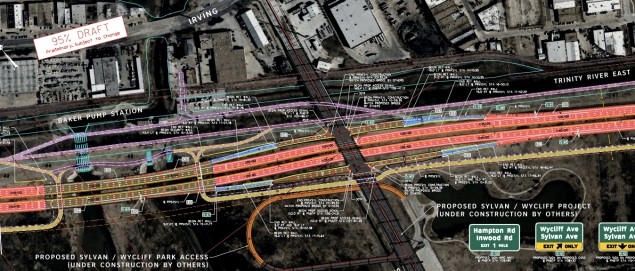
CORRECTION (4/25/14): I got the list of names of people who attended the three-day meeting in Reunion Tower from a document I wasn’t supposed to have. I used that document and language in the advisory committee’s report, which referenced a “consultant team working for the city of Dallas,” to arrive at the division I presented in paragraph four, below (AIA folks vs. folks working for the city). The second group of people did not work for the city. They belonged to a “Professional Resource Group” that assisted the AIA’s advisory committee. My apologies.
ORIGINAL POST: Tonight brings us the final chance for the public to be heard on the matter of whether we should build a six-lane toll road along the Trinity River. The gig at the convention center will be hosted by the NTTA and TxDOT. A mixer of sorts begins at 5, and the formal public hearing starts at 7. You can get more details here.
Let’s jump in our time machine and go back to the year 2001. That’s when the Dallas chapter of the American Institute of Architects put together an advisory committee to have a hard look at the city’s Trinity River Corridor Master Implementation Plan. The committee met for three days up in Reunion Tower with consultants who were working for the city of Dallas. When they emerged from those meetings, the architects issued this critique, which was adopted by Dallas AIA and in November 2001 became a part of the group’s official stance on the Trinity Corridor Project.
From Dallas AIA, these were the people who attended those meetings and drafted the critique: Pablo LaGuardia, Joe McCall, Marcel Quimby, Kevin Sloan, Bill Smith, Dennis Stacey, Mike Wells, Mark Wolf, and Ron Wommack. The folks working on behalf of the city were: John DeShazo, Larry Good, Bob James, Bob Meckfessel, Rich Morgan, Sally Johnson, and Willis Winters.
Here’s the thing: the Dallas AIA folks sound aghast at the city’s plans for the Trinity Corridor. Between the lines of the formal writing, there’s a sense of shock that the plans as they existed then (largely as they exist now) are deficient. The AIA folks write that voters were tricked with fanciful renderings of sailboats on lakes. They don’t use the word “tricked,” but that is what they are saying. They point out that the city’s land-use plan is a joke, and the projections about economic development are unfounded. And, finally, the AIA folks say what now seems obvious to almost everyone except Michael Morris: a high-speed toll road should not be built through a park — that floods.
Early in their report, the architects drop some knowledge about inner-city highways and how they ruin cities, referring to Woodall Rodgers before Klyde Warren Park was built:
When originally planned, high-speed multi-lane highways were intended to by pass city centers becoming an “interstate” system of mobility, defense, and connectivity. However, lobbying governors and city mayors, believing that the high volume of “drive-by” customers would increase economic value, plunged them directly into existing city centers. With fifty years to weigh the outcome, the blurring of the high-speed multi-lane highway with strip mall reasoning has produced adverse effects on urban centers.
Rather than becoming the fastest route between cities they became the fastest route within cities. Instead of delivering economic value, their intrusiveness physically separated worker from workplace, residents from parks, child from playground and neighbors from each other. Even Dallas’ own Woodall Rogers Freeway, intentionally lowered to become more negotiable to pedestrians, still remains as a physical and psychological barrier between the prosperity of Uptown and the Arts District.
Here are their damning words about the Trinity toll road specifically:
[T]he Tollway becomes an inner liner isolating the park. Flood protection walls must be added to its interior edges since the preferred option is to place it within the levees. These conditions further restrict access and views of the park. Since the existing levees are already barriers to access, these addition elements make the park effectively inaccessible if they are implemented.
Although the Advisory Panel noted that intermittent pedestrian bridges had been shown to cross the successive barriers, no historic precedent was presented nor known to any committee member of a park with this degree of restricted and bounded access. This perception was supported by the design consultant’s own characterization of the project as “access challenged.” As a consequence, it is highly unlikely this design will generate the kind of social and economic benefits realized by other great urban American Parks.
Not only did the architects think that the placement of the toll road was a horrible idea, but they thought the very idea of the toll road was a horrible idea. You know why? Because the cities we imagined 60 years ago aren’t the cities we’re now trying to build. As in:
Presentations made to the advisory committee made clear that growth and traffic counts used to validate the Tollway, were based on assumptions that planning models of suburban sprawl and singular use of the automobile would continue unchanged in our regional culture for the next 25 years. The AP finds these assumptions narrow and inconsiderate of the cultural changes already taking place nationally as well as in Dallas. The success of light rail, pockets of newly developed high density neighborhoods such as Uptown, Addison Circle, and Legacy Town Center to name a few, clearly indicate a shift in patterns that will put worker and workplace closer together.
The report is only eight pages, but, as I say, it packs a real punch. You should find the time to read the entire thing.





